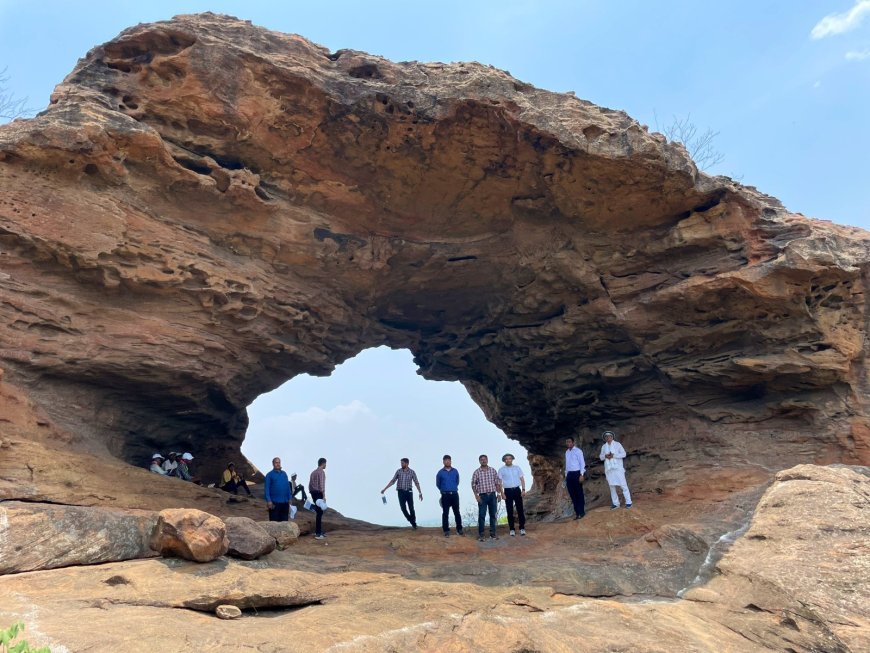Two Odisha sites under Geo Heritage list by GSI
Two Odisha sites under Geo Heritage list by GSI
Bhubaneswar: You must have heard about archaeological sites of historical importance. But some geological structures, formations, fossils and peculiar findings relating to rock and minerals and geomorphological features could also make Geological Heritage Sites.
Interestingly, there are two declared Geological Heritage Sites in Odisha bu GSI (Geological Survey of India). While one is the majestic Natural Arc in Sundargarh district on the Ib Valley, the other one is at Nomira Pillow Lava in Keonjhar District.
According to the GSI published ``Geo Tourism Hotspots of India’’ in 2020 during the 36th International Geological Congress in New Delhi (virtual) under the presidentship of Rajendra Singh Garkhal, Director General, GSI, India has got 78 approved Geological Heritage Sites by the Ministry of Mines, out of which 32 are declared as National Geological Monuments including some World Heritage Sites as well.
Natural Arc Sundargarh
The beautiful natural arch with profuse preservation of sedimentary structures has been found in the geological era of Kamthi Formation, Upper Gondwana Group at Ib River Coalfield within dense Chhengapahar Reserve forest near Brahmani Village. The location of the arch is extremely difficult to reach the site it is surrounded by the cliffs and steep-sloped hills from almost all sides. The presence of wildlife such as bears poses additional threats to the visitors.
However, it is interesting to mention that the site is structurally triggered, weathered and eroded natural arch. Since the area contains a natural arch and also has profuse preservation of sedimentary structures of early Mesozoic fluvial dynamics, efforts should be undertaken by all agencies concerned to preserve this place as a National Geological Monument. It could also be developed as an interesting tourism site and included as a new feather in the crown of the natural history of our State.
The site can be reached from the nearest airport Jharsuguda (42 km) and the nearest railway stations are Belpahar (22 km) and Jharsuguda (42 km). There are various types and categories of hotels and lodges available for a budget price at Belpahar and Jharsuguda.
Nomira Pillow Lava, Keonjhar
This site is a place dotted with well-preserved pillow lava structures in Nomira, Keonjhar district and situated about 18 km south of Joda town lying on Keonjhar- Barbil- Lahunipada State Highway. It was declared as a National Geological Monument and opened on December 30, 1976. The monument can be approached from Joda by following Joda-Nayagar Road up to Bamebari and then following a 2 km unmetalled road leading eastward up to Nomira.
The pillow lava structures are roughly ellipsoidal and closely packed with a maximum thickness of 2m x 0.6m. They are closely packed with the convexity of one fitting the concavity of the other. Grain size within the pillows is found to decrease toward the margin.
The pillow lava structure suggests that once the area was under active volcanic activity and the escaping occluded gases from the molten lava have resulted in radial, elliptical and tubular structures. The volcanics of Nomira, occurring below the banded iron formation of Jamda-Koira belt and containing pillow structures, indicate the sub-aqueous nature of the flow meaning it was once under a shallow submarine volcanic activity.
If one is interested to reach the place then the nearest airport is Bhubaneswar (202 Km) and the nearest railway station is Baspani (70 Km). A number of hotels are available in Keonjhar town. The site is well connected by roads with major cities of Odisha.
Tourism Potential
Just like the archaeological sites under the Archaeological Survey of India, the Geological Heritage Sites are also important tourism destinations and they should have better visibility on the tourism map so that more tourists, especially students would visit them and learn the basics of geology to know and imagine how the earth was formed millions and millions of years before and how the transformative processes had changed the geo-morphology.
(EOM)
What's Your Reaction?





























































